
Boonsboro is a town in Washington County, Maryland, United States, located at the foot of South Mountain. It nearly borders Frederick County and is proximate to the Antietam National Battlefield. The population was 3,336 at the 2010 census.
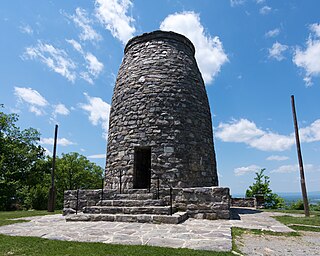
Washington Monument State Park is a public recreation area located approximately one mile (1.6 km) southeast of Boonsboro, Maryland. The park preserves the Washington Monument, a 40-foot-tall (12 m) tower honoring George Washington, the first President of the United States. The monument sits along the Appalachian Trail near the summit of South Mountain's Monument Knob. It was added to the National Register of Historic Places in 1972. The park is managed by the Maryland Department of Natural Resources.

The Keating House at 208 South Liberty Street in Centreville, Maryland is a Federal style house built c. 1806-1809 by Ebenezer Covington. The interior is particularly well-preserved.
The Monocacy Site is an archeological site located along the Potomac River. The site spans several eras ranging from Archaic period to the early Woodland period. Projectile points, pottery and soapstone vessels have been found here, with pottery dated to c. 1145-865 BC. The site is the deepest known stratified site in Maryland.

The "Old National Pike Milestones" marked each mile of the old National Road in Maryland, an eastern coastal state of the United States, from its dominating city of Baltimore to major towns of western Maryland, as Frederick, and between it and Hagerstown, to Hancock, through to Cumberland in the western panhandle of the state in the foothills of the Appalachian Mountains. The surviving stones have been included in the "National Register of Historic Places", maintained by the National Park Service of the U.S. Department of the Interior, and may be seen along the route variously designated as U.S. Route 40, Maryland Route 144, Alternate U.S. Route 40, and several other roads that trace the path of the original "Old National Pike". From Baltimore to Cumberland, the road was surveyed and laid out with construction in several phases over different periods of time by several turnpike companies, chartered by the General Assembly of Maryland beginning in 1808. Earlier in 1806, the United States Congress with the approval of third President Thomas Jefferson, authorized the surveying and further construction of a "national road" to continue on from Cumberland on the upstream of the Potomac River further to the west across additional mountainous ranges in the Allegheny Mountains to the newly admitted State of Ohio. Later the congressional action was amended to direct the road to the state boundaries on the Ohio River and it eventually landed at Wheeling, West Virginia. In later decades, the road was extended west across Ohio, Indiana and into the Illinois Country, to eventually terminate by the 1840s in Vandalia, the territorial capital of Illinois, just east of the Mississippi River, and northeast of the newly emergent, frontier river port metropolis of St. Louis of the Missouri Territory and the former Louisiana Purchase of 1803 to the west.

The Robert Llewellyn Wright House is a historic home located at 7927 Deepwell Drive in Bethesda, Maryland. It is an 1800-square foot two-story concrete-block structure designed by architect Frank Lloyd Wright in 1953, and constructed in 1957 for his sixth child, Robert Llewellyn Wright (1903–86), who worked at the Justice Department.
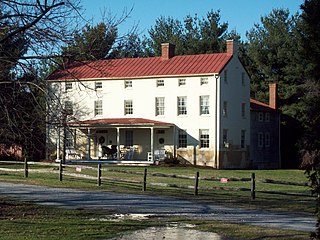
The Benson–Hammond House is a historic house located on Poplar Avenue in Linthicum Heights, Anne Arundel County, Maryland.
Brinsfield I Site, or Brinsfield I Prehistoric Village Site, is an archaeological site near Cambridge in Dorchester County, Maryland. The site was first identified in 1955 by Perry S. Flegel of the Sussex Society of Archaeology & History. It is a late prehistoric archaeological site characterized by shell-tempered pottery and triangular projectile points. The site may provide evidence of prehistoric life on the eastern shore of Maryland during the Late Woodland period, c. 900–1500.
Shoemaker III Village Site is an archaeological site near Emmitsburg, in the extreme northern section of Frederick County, Maryland. Pottery fragments, projectile points, and other artifacts found at the site date it to 900–1300.
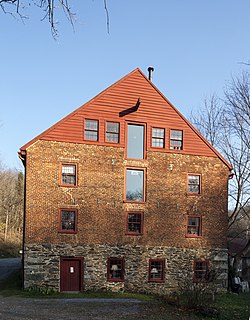
Lewis Mill Complex is a historic grist mill complex located at Jefferson, Frederick County, Maryland. The complex consists of seven standing structures, a house foundation, and the remains of an earlier millrace. It centers on an early 19th-century three-story brick mill structure with a gabled roof. The mill complex served German immigrant farmers in Middletown Valley between 1810 and the 1920s. It was rehabilitated in 1979-1980 for use as a pottery shop. Also in the complex are a stuccoed log house and log springhouse built about; a frame wagon shed and corn crib structure and frame barn dating from the late 19th century; and early 20th century cattle shelter and a frame garage.
Ingram–Schipper Farm is a historic farm complex located near Boonsboro, Washington County, Maryland, United States. It is a two-story, four-bay Flemish bond brick dwelling with white trim and water table. The house features a Victorian period flat-roofed one-story porch and a slate roof. The property includes a number of early outbuildings, including a brick kitchen and wash house, three log buildings, one of which has a fireplace and appears to have been a dwelling, and a large stone barn.

The Keedy House is a historic home located at Boonsboro, Washington County, Maryland, United States. It is a 2+1⁄2-story home, three bays wide and two deep, built of coursed gray stone about 1790. Also on the property is a small stone bank house with a two-story porch and a small stone springhouse.
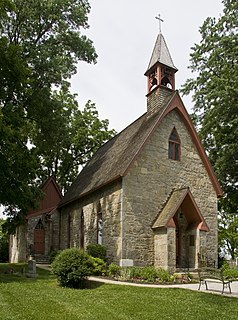
St. Mark's Episcopal Church is a historic Episcopal church located at Boonsboro, Washington County, Maryland, United States. Originally formed within Saint John's Parish, it was incorporated into Antietam Parish in 1899.

Stone Hill Historic District is a national historic district in Baltimore, Maryland, United States. It is one of the original mill villages along the Jones Falls, having been developed circa 1845–1847 to house textile mill workers. Comprising seven blocks, the district includes 21 granite duplexes, a granite Superintendent's House, and a granite service building – all owned by Mount Vernon Mills from 1845 to 1925.

Oakenshawe Historic District is a national historic district in Baltimore, Maryland, United States. It comprises 334 buildings which reflect the neighborhood's development during the period 1890 to about 1926. The neighborhood evolved in two stages on the 19th century Wilson estate. The first phase of growth is represented by frame houses dating from 1890 to about 1910 reflecting vernacular interpretations of the Victorian Gothic and Italianate styles. The second stage of development began in the World War I era, when several developers transformed the property by constructing a neighborhood of brick "daylight" rowhouses in revival styles popular at the time.
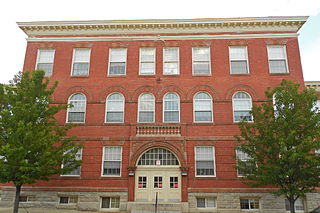
Franklin Square Historic District is a national historic district in Baltimore, Maryland, United States. It is a 19th-century rowhouse neighborhood developed along a strict grid street pattern. A one square block, two and a half acre public park, Franklin Square, is a focal point for the area and the most elaborate rowhousing surrounds the square. The district contains approximately 1,300 buildings of which approximately 1,250 contribute to the significance of the historic district.

Franklintown Historic District is a national historic district in Baltimore, Maryland, United States. It is the result of a plan developed in 1832 by William H. Freeman (1790–1863), a local politician and entrepreneur. His plan evolved gradually over the course of several decades and owes its success to his untiring promotion of the village. The central feature is an oval plan with radiating lots around a central wooded park. The district includes an old stone grist mill known as Franklin Mill, the innovative radiating oval plan, and the associated hotel and commercial area. The key residential buildings are excellent examples of the "I"-house form and display steeply pitched cross gables found in vernacular rural buildings throughout much of Maryland.
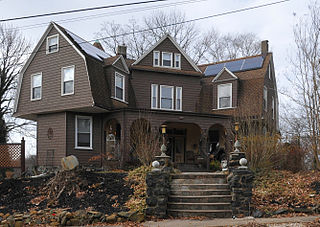
Windsor Hills Historic District is a national historic district in Baltimore, Maryland, United States. It is a cohesive residential suburb defined by rolling topography, winding, picturesque streets, stone garden walls, walks and private alley ways, early-20th century garden apartments, duplexes, and freestanding residences. Structures are predominantly of frame construction with locally quarried stone foundations. Windsor Hills developed over a period from about 1895 through 1929. The dominant styles include Shingle cottages, Dutch Colonial Revival houses, Foursquares, and Craftsman Bungalows.

Boonsboro Historic District is a national historic district at Boonsboro, Washington County, Maryland, United States. The district includes 562 contributing elements. Its component buildings chronicle the town's development from its founding in 1792 through the mid 20th century. Most of the late 18th and early 19th century development in Boonsboro occurred along Main Street, then part of a principal market road between Williamsport, Hagerstown, Frederick, and Baltimore, Maryland. They are mainly of log, frame, or brick construction, with a few stone buildings interspersed. The majority of the buildings in the district date from the 1820-1850 period coinciding with peak use years of the National Road. Other features of the district include the Boonsboro Cemetery laid out about 1855 in a 19th-century curving plan with a number of exceptionally artistic gravestones, and the office/depot of the Hagerstown-Boonsboro Electric Railway. The period of significance, from 1792 to 1959 tracks the continuous growth and evolution of the town through the date by which the district had substantially achieved its current form and appearance.

Keedysville Historic District is a national historic district at Keedysville, Washington County, Maryland, United States. The district boundary is within the corporate limits of the town, generally focused on the properties lining Main Street and those associated with the now-abandoned railroad facilities. It is reflective of the town's growth from the 1768 establishment of Jacob Hess' mill along the old Conococheague migration road to expansion with each new transportation development. The first major development was the Boonsboro-Sharpsburg turnpike. With the advent of the Baltimore and Ohio Railroad through the center of town, shops and manufactures were established and expanded. The town's prosperity waned with the loss of railroad service in 1953. The district is also significant for the wide range of architectural stylistic influences present on the buildings through the historic town.



















